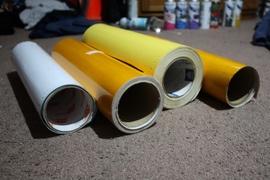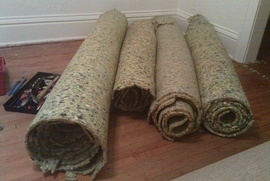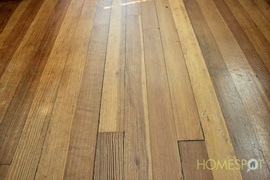How Much Does Peel-and-Stick Vinyl Flooring Cost?
One of the easiest flooring types to install and care for is peel-and-stick vinyl flooring. Peel-and-stick flooring can be installed DIY or professionally, comes in planks and tiles, and makes a beautiful floor for many rooms. Peel-and-stick vinyl flooring is thinner than other types but can go down over most substrates without issue.
The national average cost to install peel-and-stick vinyl flooring is $600 to $1,400, with most people paying around $1,000 to professionally install 200 sq.ft. of .4 mm peel-and-stick vinyl planks. This project’s low cost is $400 for 200 sq.ft. of installed .3 mm peel-and-stick tiles. The high cost is $1,600 to professionally install 200 sq.ft. of padded .5 mm peel-and-stick vinyl planks.
What Is Peel-and-Stick Vinyl Flooring?
Peel-and-stick vinyl 1 flooring is a thinner version of vinyl planks or tiles. It has an adhesive backing covered by thin paper. You peel the paper away, and then press the tile or plank to the floor. The adhesive works without separate glue, a roller, or other fasteners. Peel-and-stick flooring is very inexpensive and easy to install. It is popular with homeowners who want to do a DIY installation, but it can also be professionally installed. It is not as long-lasting as other vinyl flooring types, so it is popular for rentals, children’s bathrooms, and other areas where you may want to change the flooring in the near future.
Peel-and-Stick Vinyl Flooring Cost Calculator
Peel-and-stick vinyl flooring is a thinner material than most other types of vinyl. This means it is less expensive and easier to cut and install. It comes in varying thicknesses and shapes, and some good-quality flooring may have a pad on the back to help with acoustics and comfort. Thinner .3 mm materials are the least expensive to purchase and install, with .4 mm closer to being standard and .5 mm considered as thick as the material can be. Below are the average costs to install 200 sq.ft. of this material using different qualities.
|
Peel-and-Stick Vinyl Flooring Costs
|
|||
|---|---|---|---|
| Basic | Standard | Best Quality | |
| Peel-and-Stick Vinyl Flooring Cost (Material Only) | $100 - $200 | $200 - $500 | $600 - $900 |
| Peel-and-Stick Vinyl Flooring Installation Cost (Labor Only) | $200 - $300 | $400 - $500 | $500 - $700 |
| Total Costs | $300 - $500 | $600 - $1,000 | $1,100 - $1,600 |
| Peel-and-Stick Vinyl Flooring Cost per Sq.Ft. | $1.50 - $2.50 | $3.00 - $5.00 | $5.50 - $8.00 |
Peel-and-stick vinyl is easier to install than most other types. The thinner the material, the easier it is to install. Thicker padded 2 versions can be more stiff and difficult to cut, so they can take more effort to install, raising overall costs.
Additional Considerations and Costs
- Subfloor. Peel-and-stick vinyl can be installed over a clean subfloor 3 in good condition. It does not need to be perfectly level like click-lock vinyl.
- Underlayment. Peel-and-stick vinyl should not be installed over an underlayment 4. If you want a thicker floor, consider a padded version.
- Vinyl vapor barrier. Peel-and-stick vinyl requires a vapor barrier 5 if you install it in a damp area because the moisture may cause the floor to fail. Vapor barriers cost around $100 to $150.
- Pets. Peel-and-stick vinyl is a good floor for pets. It is low-maintenance and not impacted by pet waste or claws.
- Radiant heating. You can install radiant floor heating beneath your peel-and-stick tile. This costs $10 to $25 a sq.ft. and is more efficient than other heating types.
- Waterproof. Peel-and-stick vinyl is water-resistant and can be used in bathrooms and other wet areas.
- Lifespan. Peel-and-stick tile is not as long-lasting as other vinyl types. They have an average lifespan of 5 to 10 years.
FAQs
- Do you need underlayment for peel-and-stick vinyl?
No, underlayments are not required for peel-and-stick vinyl. You should use a vapor barrier in damp areas to help it last longer.
- How do you prepare a floor for peel-and-stick vinyl?
Ensure the substrate is clean and dry. Sweep it well to ensure nothing gets between the adhesive and the subfloor.
- Why is my vinyl floor not sticking?
There can be many reasons why a vinyl floor does not stick. If you are using peel-and-stick vinyl, ensure that the substrate is very clean and dry. Dust or dirt between the adhesive and the floor can cause it to fail. Moisture or high humidity can also cause it to fail.
- How can I make my peel-and-stick tile stick better?
Ensure the substrate is very clean and dry, with low humidity in the room. Acclimate the vinyl to the room’s temperature for at least 72 hours before installing. You can also rent a vinyl floor roller and roll the floor to help it adhere.
- How do you fix vinyl tiles that are lifting?
Depending on the tiles and substrate, you may need to replace them. The adhesive cannot be reapplied once worn out. If they lift immediately after installation, a heavy vinyl roller can help them adhere.
Remodeling Terms Cheat Sheet
Definitions in laymen's terms, cost considerations, pictures and things you need to know.See full cheat sheet.
 1 Vinyl: A synthetic plastic made from ethylene and chlorine. Vinyl has many applications in the construction industry and it is widely used in sidings, window frames, roofing and gutters, among others
1 Vinyl: A synthetic plastic made from ethylene and chlorine. Vinyl has many applications in the construction industry and it is widely used in sidings, window frames, roofing and gutters, among others
 2 Padded: A cushion placed under a carpet to absorb impact, thus extending the life of the carpet
2 Padded: A cushion placed under a carpet to absorb impact, thus extending the life of the carpet
 3 Subfloor: The bottom-most layer of a floor, supported by joists, over which finished flooring material is laid
3 Subfloor: The bottom-most layer of a floor, supported by joists, over which finished flooring material is laid
How much does it cost to install peel-and-stick vinyl flooring in my city?
Cost to install peel-and-stick vinyl flooring varies greatly by region (and even by zip code). To get free estimates from local contractors, please indicate yours.

